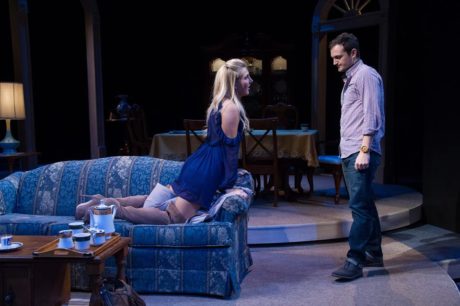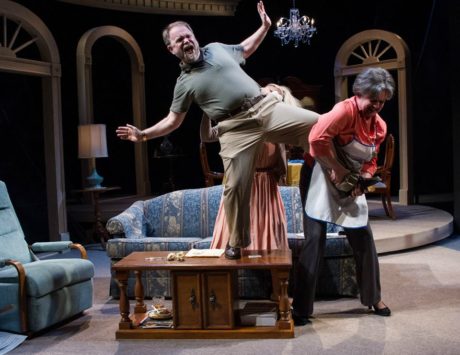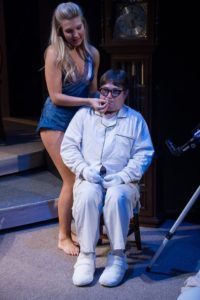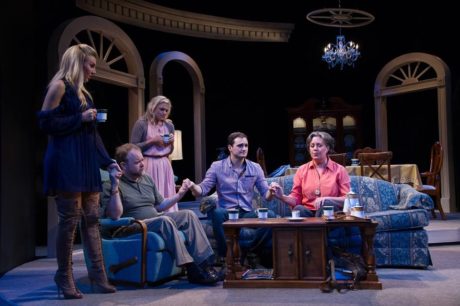There have been so many plays about dysfunctional families—think about August: Osage County, for example, or The Sisters Rosensweig—that it’s hard to believe that anyone would try to produce another one about warring siblings coming together after a parent’s death. Yet, in the hands of Adam Immerwahr, Theater J’s newly appointed Artistic Director, The Last Schwartz is as fresh and funny and genuinely moving as if it were the first play to explore the concept.

The set-up is simple. The Schwartz children—all between 30 and 50—have returned to their empty childhood home for a memorial service for their father, who died a year earlier.
Norma, the oldest of the four, and the only daughter, has assumed the matriarchal role. Played by Barbara Pinolini with a Molly Goldberg aura, Norma is aggressively Jewish and self-righteous. She is a pompous upholder of 1950’s tradition, and is also slightly ridiculous and maddening. She orders the others to respect their parents, keep their feet off the furniture, polish the silver and carry the good dishes carefully. She also insists on telling stories that everyone—except the newcomers—has heard before. It is Norma, of course, who—when she discovers that her youngest brother has brought a girlfriend along—tells the Hollywood starlet to sleep separately, on the couch.

The oldest brother, Herb, played by Sasha Olinick, is rich, practical, impatient, and unmistakably horny. When Norma demands that he take his feet off the battered old coffee table, Olinick erupts in a rage, climbs on the table, and dances a vindictive jig. He stomps up and down like Rumpelstiltskin and is hilarious to watch.
Herb’s wife, Bonnie, is played by the elegant Anne Bowles. She’s tearful and emotionally needy, so much so that Herb tends to tune her out. As a result, she can’t stop talking. She’s also a convert to Judaism, a fact that Norma uses like a cudgel, attacking her whenever she can.
Simon, the second brother, is a scientist going blind. An astronomer who can no longer see the stars through his telescope, Simon instead resurrects his childhood memories of planets orbiting the sun.

Andrew Wassenich, who is making his debut at Theater J, is extraordinary in the role of an outcast. His isolation, from both the family and the world, is complete. While the family exchanges insults and confidences, Simon is alone in a world that only he can see. He’s also the only one in the play—and perhaps in the theater—who understands that life as we know it is doomed.
Gene, the youngest of the Schwartzes, is played with almost wily languor by Billy Finn. Gene is a director of TV commercials, described glowingly by his girlfriend as someone who—unlike all the other directors—actually gave her the part when she agreed to sleep with him for it.
Kia, the girlfriend, is the star of his latest commercial, for a product called “Fat No More.” In fact, she is the face-and form-of “Fat No More,” and is ecstatically proud of her fame.
Emily Kester literally inhabits the role with comedy so broad that she brings the house down whenever she opens her mouth. (In one case, her method of lighting a toke had the audience roaring before she can even do it.) She’s a classic California-style blond—a modern-day Marilyn Monroe—who happens to be the carefree child of one of the members (she’s not sure which) of a hippie commune in Venice.
All of the actors are perfectly cast, thanks to Theater J’s Resident Casting Director Naomi Robin.
Set in a dying Catskills community in Upstate New York, The Last Schwartz is the first of seven plays written by Deborah Zoe Laufer. It was originally produced in 2003 by the now defunct Florida Stage, where it won raves and inclusion in Women Playwrights: the Best Plays of 2003.
The play was optioned for Broadway but was never produced. As a result, it is just now having its DC premiere at Theater J. Laufer’s subsequent plays have been produced at Steppenwolf Theatre Company in Chicago, Primary Stages in New York and more than 80 other theaters in the US, Germany, Russia, and Canada. Laufer herself grew up in Liberty, NY, in the heart of a Borscht Belt community that had seen better days.
The play is set is the living area of a 1930’s house. Designed by James Fouchard, the single set is beautifully proportioned, with high ceilings, arched windows and doors, moldings that float overhead like a roof, and a crystal chandelier. At stage front are the coffee table, a recliner that no longer works, and a slightly saggy couch. Behind them are a formal dining table with mismatched chairs, and a breakfront full of treasures that nobody wants nowadays.
Lighting Designer Nancy Schertler uses light and shadow to suggest the passage of time or change of focus. The lights are bright when people are arguing, dim when the family is at dinner, and dark when they gather at the cemetery to recite the Kaddish (The Jewish mourners’ prayer). Simon, whose isolation is scary and sad, is mostly in shadow. But under the spotlight, he glows.

Costume Designer Kelsey Hunt has designed some incredibly sexy outfits for Kia, including an astonishing pair of calf-high lace-up boots. Norma’s clothing, on the other hand, is so dowdy, that I wondered, more than once, if she was wearing her mother’s clothes. Simon’s outfit, as befits his character, resembles that of someone who dreams of living on the moon..
Kevin Laughon is the source of a collection of props that function as plot devices. There is the silver cup that was given to Grandma, the chipped pitcher that must be held carefully, and many others. And umbrellas form a silhouette of mourning as the family gathers to pray.
Thanks to Production Stage Manager Karen Currie, there is constant movement in what could otherwise have been a talky play. Apart from Herb dancing on the table, people come and go through windows and doors. Conversations are overheard.
For Immerwahr, the play is about legacy: “I knew it was the perfect way to start my first season at Theater J,” he says, pointing out that on the surface, the play is about whether this particular Jewish family can hold onto the religion that was so central to their parents’ identities. “It’s also,” he added, “about the need to belong and connect…and the need to pass a piece of ourselves on to the next generation.”
In other words, you don’t need to be Jewish to enjoy Theater J’s production of The Last Schwartz. It’s a play that will resonate with all audiences, reminding us of our mortality and the need to move on.
Running Time: Two hours, including an intermission.
The Last Schwartz plays through October 2, 2016 at Theater J at The Washington DCJCC’s Aaron & Cecile Goldman Theater –1529 16th Street, NW (16th and Q Streets), in Washington, DC. For tickets, call the box office at (202) 777-3210, or purchase them online.
RATING:





